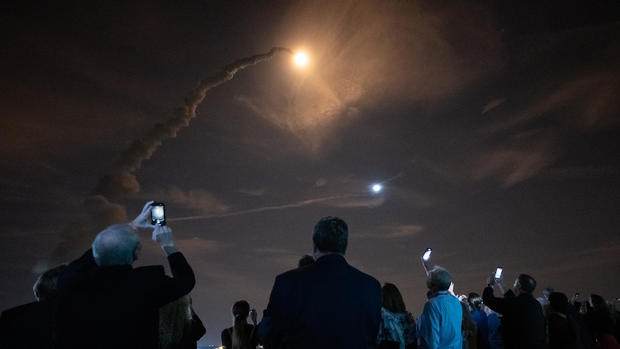NASA's Orion capsule heads for home on final leg of Artemis 1 moon mission
Passing within a scant 81 miles of the moon, NASA's unpiloted Orion capsule fired its main engine Monday in a gravity-assist lunar flyby that put the ship on course for a return to Earth Sunday to close out the Artemis 1 test flight.
The 3-minute 27-second burn, starting at 11:43:23 a.m. EST, took place on the far side of the moon while the spacecraft was out of contact with flight controllers at the Johnson Space Center in Houston.
But the orbital maneuvering system engine worked flawlessly, firing on time with 6,000 pounds of thrust to change the capsule's velocity by 655 mph. The burn set up a precisely-targeted re-entry and splashdown in the Pacific Ocean west of San Diego at 12:40 p.m. EST Sunday.

Plunging back into the discernible atmosphere at some 25,000 mph, the Orion's heat shield will have to withstand temperatures as high as 5,000 degrees as it dives in, skips back out slightly and then re-enters for good, slowing to just 117 mph by the time its main parachutes deploy two-and-a-half minutes before splashdown.
With a joint NASA-Navy recovery team standing by, the Orion will hit the water at a relatively sedate 20 mph to close out a 25-day voyage spanning 1.4 million miles since launch November 16 from the Kennedy Space Center atop NASA's first Space Launch System super heavy-lift rocket.

The recovery team, based on a Navy amphibious transport ship, will be standing by to haul the capsule into an enclosed "well deck" for the trip back to shore where it will be subjected to detailed post-flight inspections to verify the performance of its heat shield and other systems.
The Artemis 1 mission is the first in a series of NASA flights aimed at sending astronauts back to the moon for long-term exploration and technology development intended to pave the way toward eventual piloted flights to Mars.
The program is targeting future landings near the moon's south pole where ice deposits may be found in permanently shadowed craters, potentially providing a source of air, water and rocket fuel for future exploration.
The Artemis 1 mission was designed as an unpiloted maiden test flight of both the Orion capsule and the Space Launch System rocket that boosted the spacecraft onto a trajectory to the moon. Despite repeated hydrogen leaks and other glitches that triggered multiple delays, the giant rocket chalked up a near-flawless climb to space.

The Orion capsule and its European Space Agency-supplied service module have also performed well. While the mission's top objective — testing the heat shield at lunar re-entry temperatures — has not yet been accomplished, there have been no other major problems that would prevent or significantly delay subsequent flights.
The spacecraft carried out an initial lunar flyby on November 21, followed by another OMS engine firing four days later to put the craft into a "distant retrograde orbit" that carried Orion farther from Earth — 268,563 miles — than any previous human-rated spaceship.
While on the DRO trajectory, flight controllers put Orion and its service module through their paces, testing the vehicle's navigation, propulsion, thermal control and computer systems in the deep space environment to verify they work as expected.
Another OMS engine firing last Thursday took Orion out of its lunar orbit, sending the craft back toward the moon for Monday's powered flyby. In all cases, the OMS engine, which first flew in space nearly four decades ago during a 1984 shuttle flight, performed exactly as expected.
NASA plans to follow the Artemis 1 mission by launching four yet-to-be-named astronauts on a shakedown flight around the moon in 2024, using GPS receivers, phased array antennas and an inertial measurement unit taken from the Artemis 1 Orion.
The Artemis 2 mission, in turn, will set the stage for the first woman and the next man to land near the lunar south pole in the 2025-26 timeframe.
But that flight will depend on a new SpaceX lander, a variant of the company's yet-to-fly Starship, and NASA has provided few details on that spacecraft's development or test schedule.
- In:
- Artemis Program
- NASA

Bill Harwood has been covering the U.S. space program full-time since 1984, first as Cape Canaveral bureau chief for United Press International and now as a consultant for CBS News. He covered 129 space shuttle missions, every interplanetary flight since Voyager 2's flyby of Neptune and scores of commercial and military launches. Based at the Kennedy Space Center in Florida, Harwood is a devoted amateur astronomer and co-author of "Comm Check: The Final Flight of Shuttle Columbia."
TwitterDisclaimer: The copyright of this article belongs to the original author. Reposting this article is solely for the purpose of information dissemination and does not constitute any investment advice. If there is any infringement, please contact us immediately. We will make corrections or deletions as necessary. Thank you.







